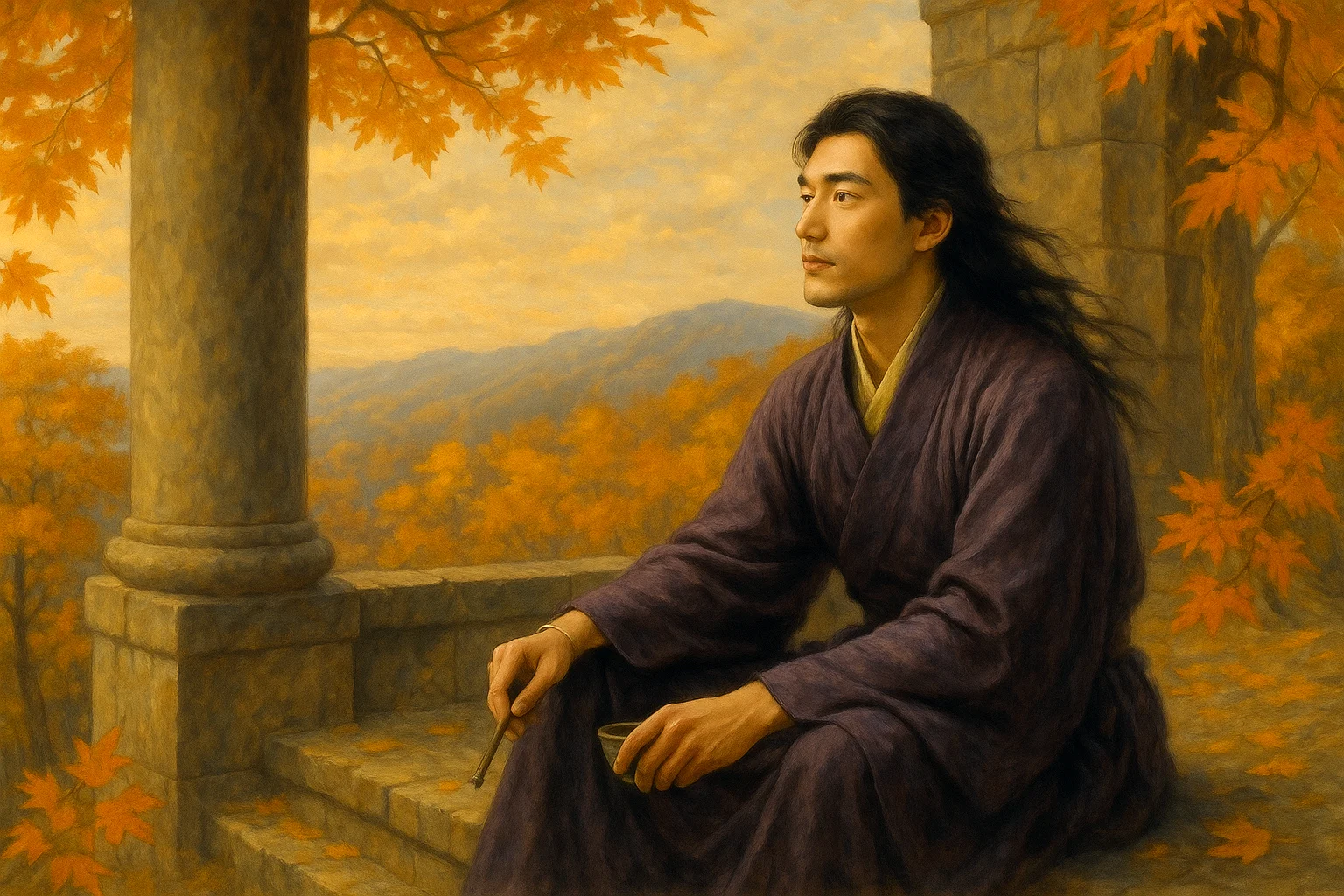At dusk, yellow clouds merge in gloom,
Years deep, white bones grow few in tomb.
Old village trees still stand upright,
Autumn grasses mark the distant flight.
Abandoned wells with thick moss crowned,
Overgrown fields where paths are drowned.
Only the nearby hills remain in sight,
Facing each other, seeming to bid goodnight.
Original Poem
「宋中」
耿玮
日暮黄云合,年深白骨稀。
旧村乔木在,秋草远人归。
废井莓苔厚,荒田路径微。
唯馀近山色,相对似依依。
Interpretation
Composed during Geng Wei's travels through Songzhou (modern Shangqiu, Henan), this poem reflects on a region historically ravaged by war. As a strategic battleground since antiquity, Songzhou bore particularly brutal scars from the An Lushan Rebellion - its people scattered, fields left fallow. Witnessing these ruins during the Dali era, Geng Wei channels profound grief for his times and vanished lives through this stark meditation on postwar desolation. With restrained yet piercing imagery, the poem paints a landscape of abandonment where withered grasses and cold mists veil deep historical sorrows.
First Couplet: "日暮黄云合,年深白骨稀。"
Rì mù huáng yún hé, nián shēn bái gǔ xī.
At dusk, sulfurous clouds congeal overhead;
Years have thinned the battlefield's unburied dead.
The opening couplet establishes an apocalyptic tone. "Sulfurous clouds" (黄云合) evoke both literal war-torn skies and symbolic oppression, while "thinned…dead" (白骨稀) reveals time's eerie erasure of carnage - the bones now scarce not from burial but decay. The juxtaposition of "dusk" (日暮) and "years" (年深) collapses temporal distances, creating visceral historical vertigo.
Second Couplet: "旧村乔木在,秋草远人归。"
Jiù cūn qiáo mù zài, qiū cǎo yuǎn rén guī.
Village ancestors - these towering trees remain;
Through autumn grasses, wanderers trail home in vain.
Here stands the dialectic of permanence and loss. The "towering trees" (乔木) - silent witnesses to generations - now dwarf the returning stragglers. "Autumn grasses" (秋草) symbolize nature's reclamation, while "in vain" (远人归) suggests homecoming's impossibility when home no longer exists. The couplet vibrates between ecological endurance and human fragility.
Third Couplet: "废井莓苔厚,荒田路径微。"
Fèi jǐng méi tái hòu, huāng tián lù jìng wēi.
Moss carpets the abandoned well's cold mouth;
Footpaths faint like scars across the blighted south.
The postwar inventory continues with forensic precision. The "moss-choked well" (废井莓苔) and "vanishing footpaths" (路径微) document civilization's recession. The character 微 (faint) resonates profoundly - these are not just overgrown trails but evaporating human imprints, nature quietly dissolving history's pencil marks.
Fourth Couplet: "唯馀近山色,相对似依依。"
Wéi yú jìn shān sè, xiāng duì sì yī yī.
Only the mountains keep their steadfast hue,
Gazing back as if they, too, longed for you.
The finale achieves heartbreaking transcendence. The "steadfast mountains" (近山色), now sole witnesses to human absence, are anthropomorphized into mournful companions. This "gazing back" (相对依依) creates a sublime reciprocity - where landscape becomes the last keeper of memory, offering the poet solace through shared loneliness. Geng Wei's signature fusion of scene and sentiment reaches its zenith here, where geological endurance mirrors poetic remembrance.
Holistic Appreciation
The poem constructs a "landscape of war's aftermath" through a series of historically scarred images—the dusk's yellow clouds, desolate post-war villages, scarce returning survivors, and barely discernible paths. Rather than expressing emotion directly, the poet coolly lays out these scenes, culminating in the symbolic weight of "the mountain's hues nearby," transforming the poem's tone from anguish to ethereal resonance. The spatial composition is striking: from celestial phenomena to villages, then fields and nearby mountains, the perspective shifts like a camera zooming in—from panorama to intimate detail—before settling into a silent communion between human consciousness and nature. This restrained yet profound approach elevates the poem beyond the typical serenity of pastoral verse, bringing it closer to an epic quality.
Artistic Merits
- Emotion Latent in Scenery, Depth Without Ostentation: The poem avoids emotional outbursts, instead embedding grief within its imagery, making the sorrow all the more piercing.
- Spatial Progression, Layered Depth: The shifting focus—sky, village, barren fields, mountain hues—creates a fluid poetic space that draws the reader inward.
- Weighty Imagery, Far-Reaching Symbolism: Lines like "scattered white bones," "faint paths," and "lingering mountain hues" carry potent symbolism, evoking history's vicissitudes and life's impermanence.
- Quiet Language, Profound Impact: Though composed of plain words, the poem is masterfully controlled—restrained yet deeply moving, exemplifying Geng Wei's signature style of "revealing contemplation within sparse tranquility."
Insights
This poem does more than depict the ruins of war; it speaks to the perennial suffering woven into human history. Amidst the cycles of time and the rise and fall of dynasties, the poet gazes upon broken landscapes with a tender heart, finding solace in the silent steadfastness of mountains. It reminds us that in the face of tragedy, a poet's task is not merely to record but to uncover warmth and resilience within desolation. The poem inspires us to emulate those mountain hues—to endure with quiet dignity and undimmed compassion, even in a world of noise and fragmentation.
About the poet

Geng Wei (耿湋, dates unknown), a Tang dynasty poet from Yongji, Shanxi, was among the "Ten Great Talents of the Dali Era." Renowned for his mastery of five-character regulated verse, his poetry is distinguished by its economical diction and tranquil imagery. While the prevailing style of Dali poetry tended toward austerity and desolation, Geng Wei developed a distinctive voice marked by understated naturalism.












